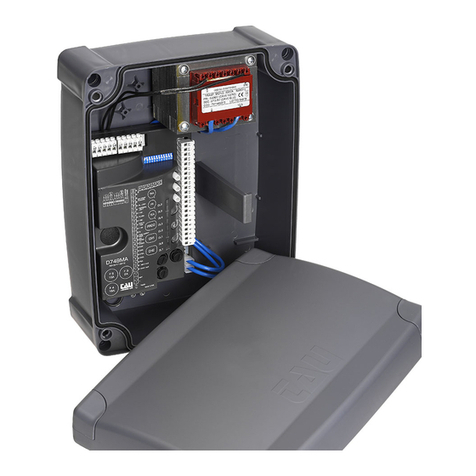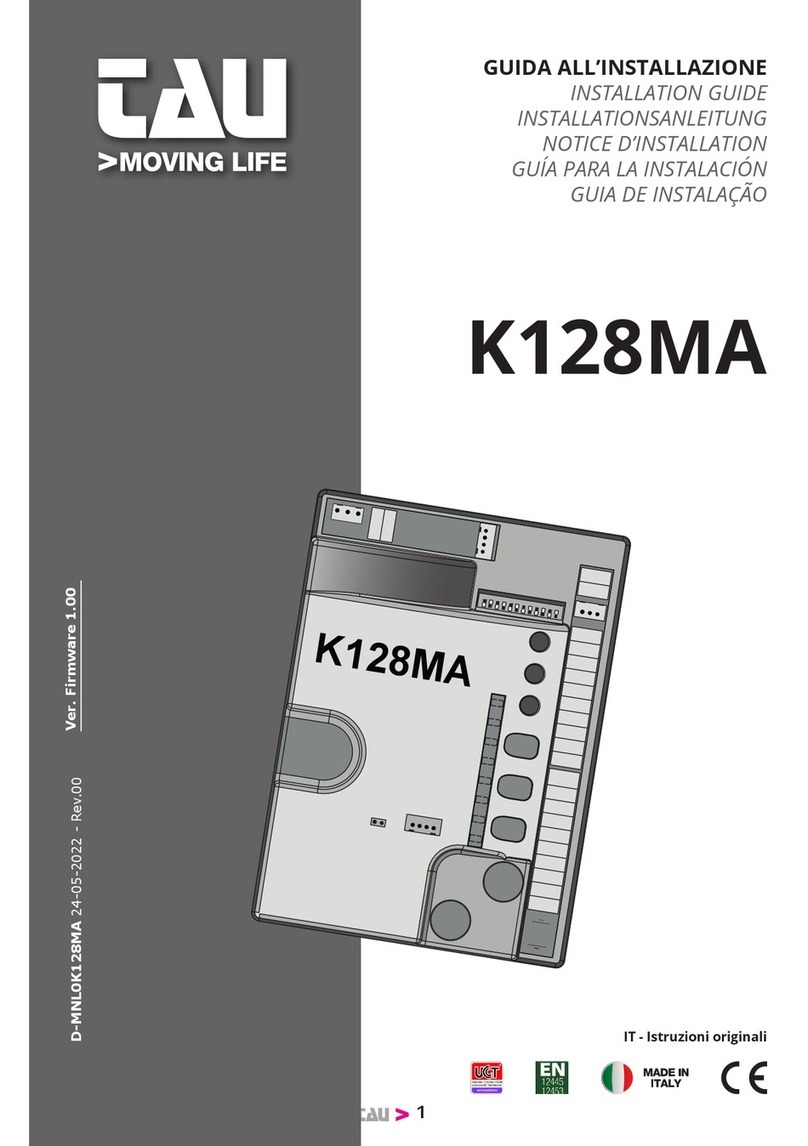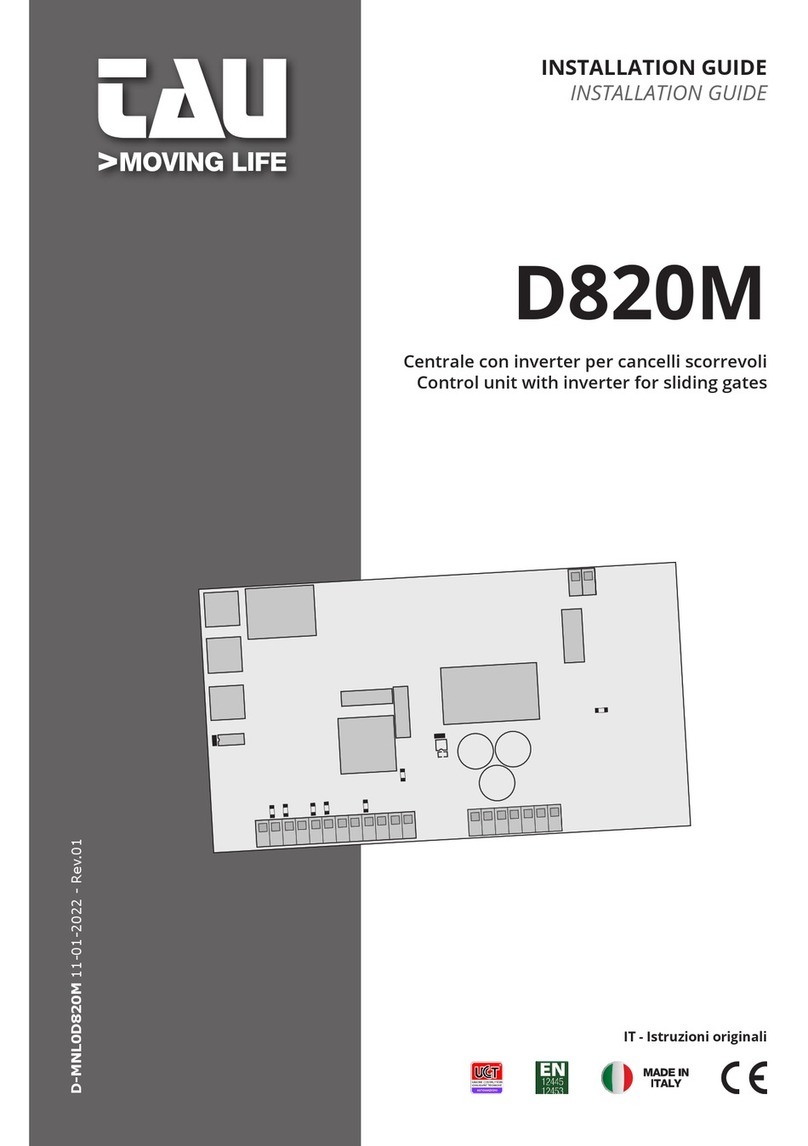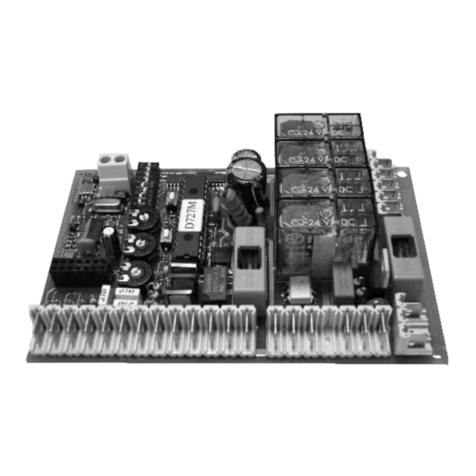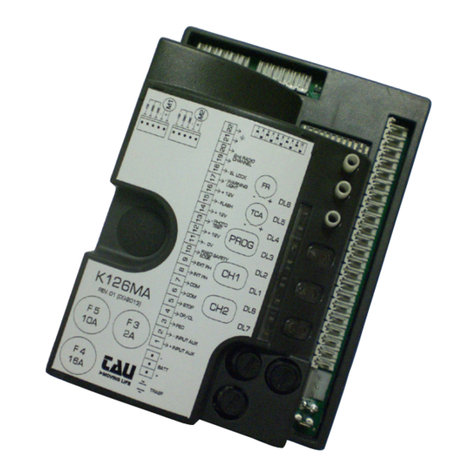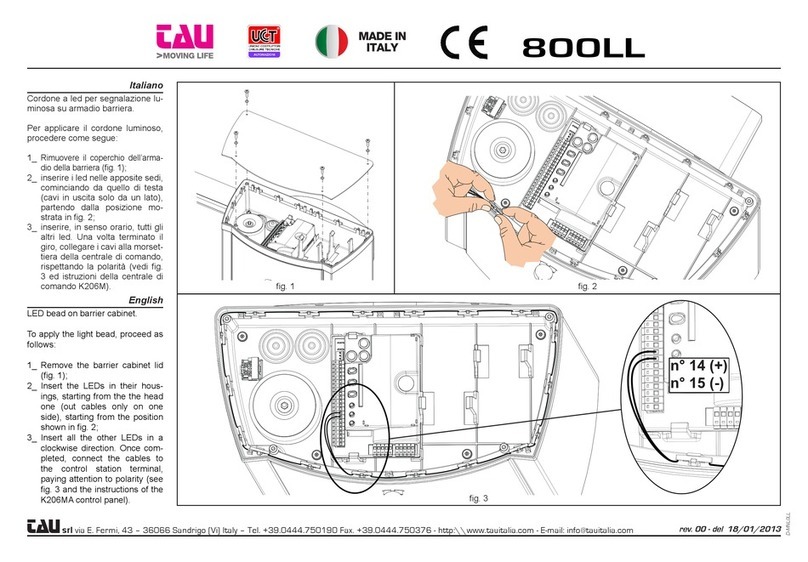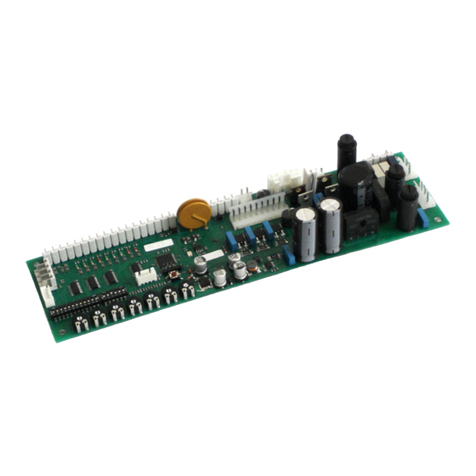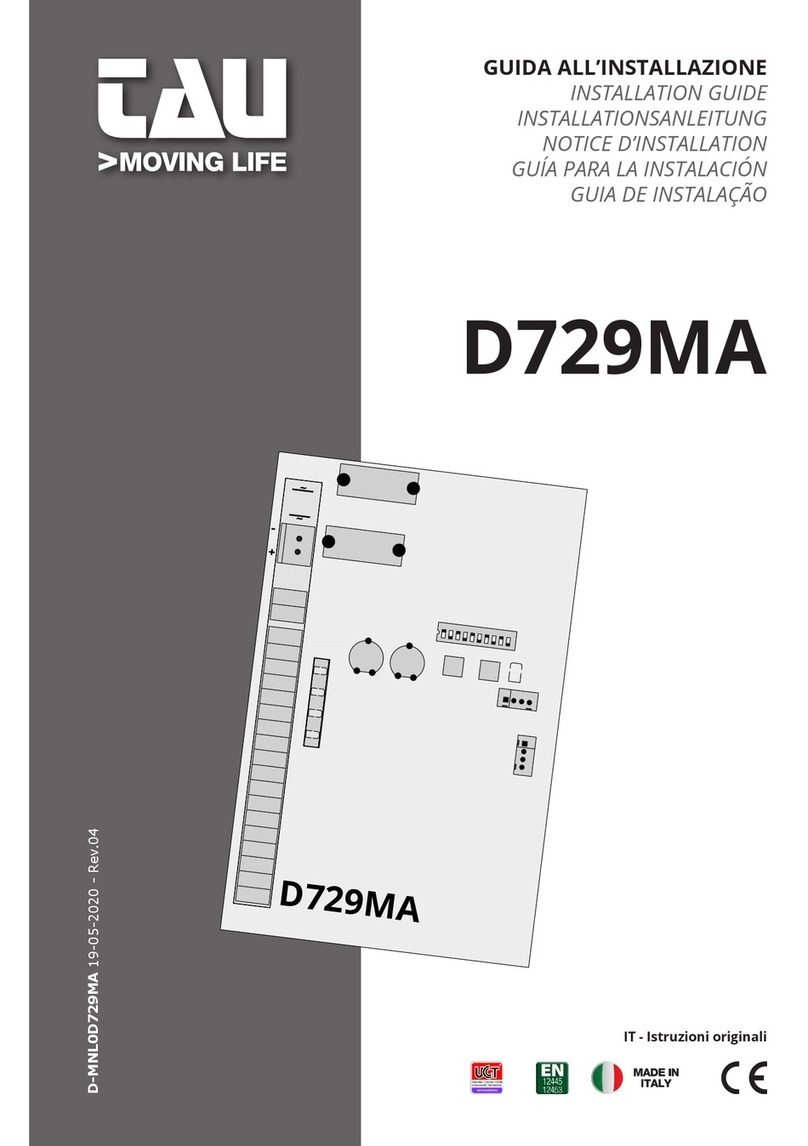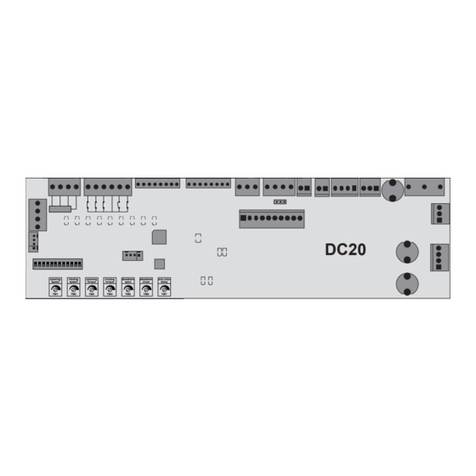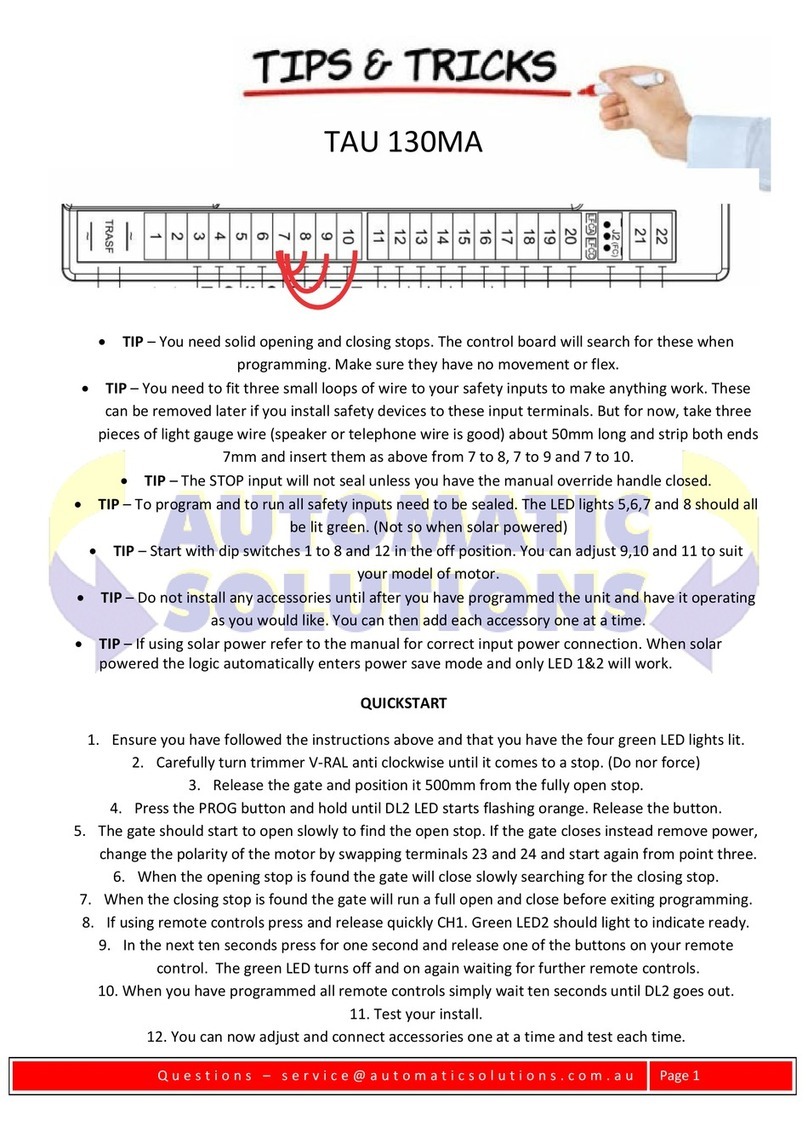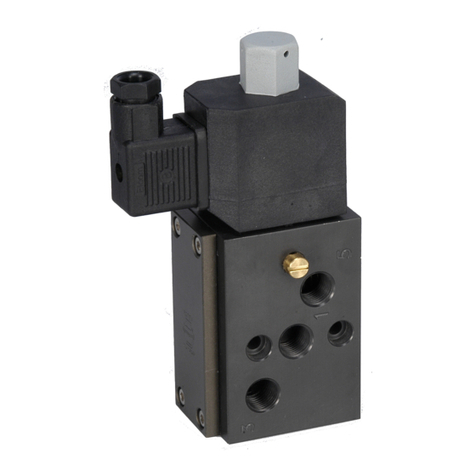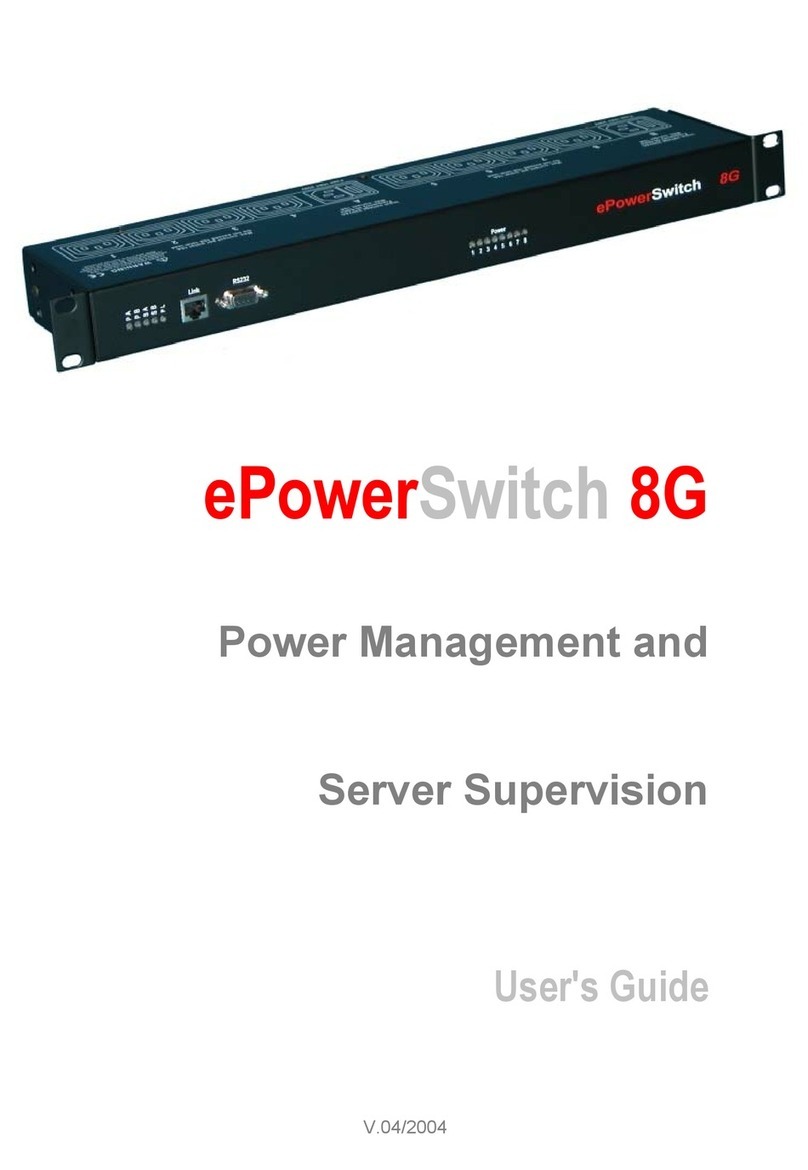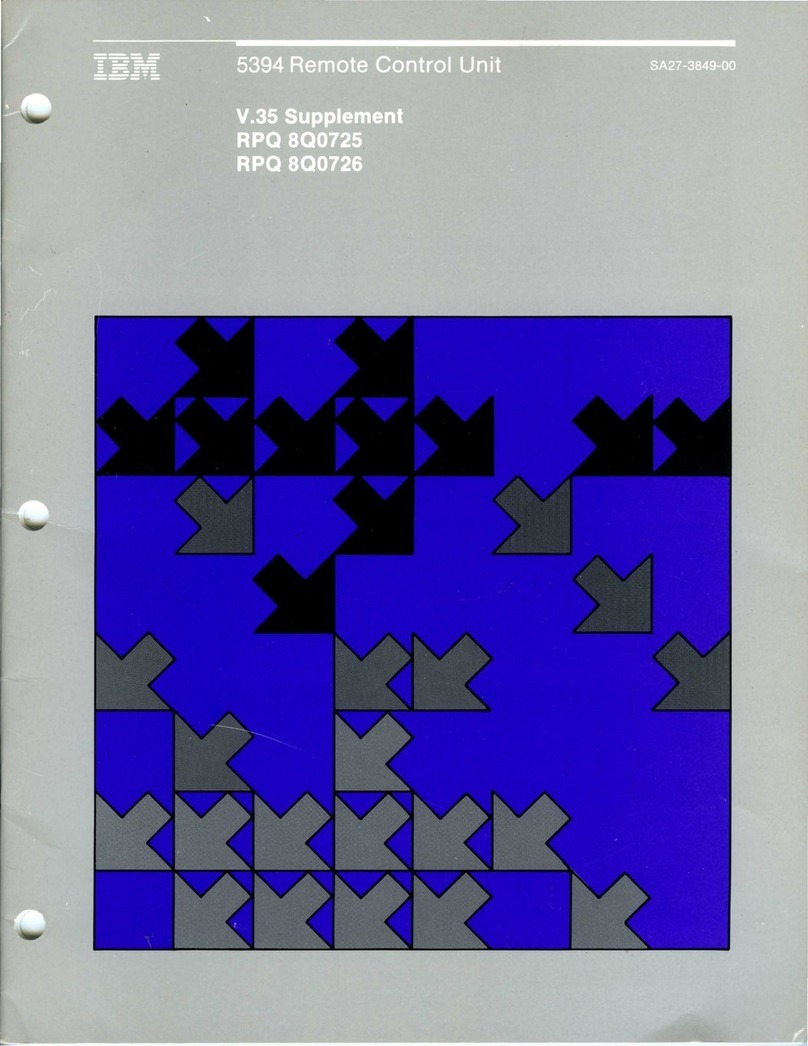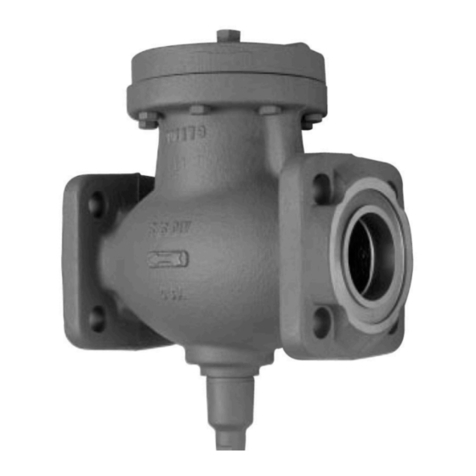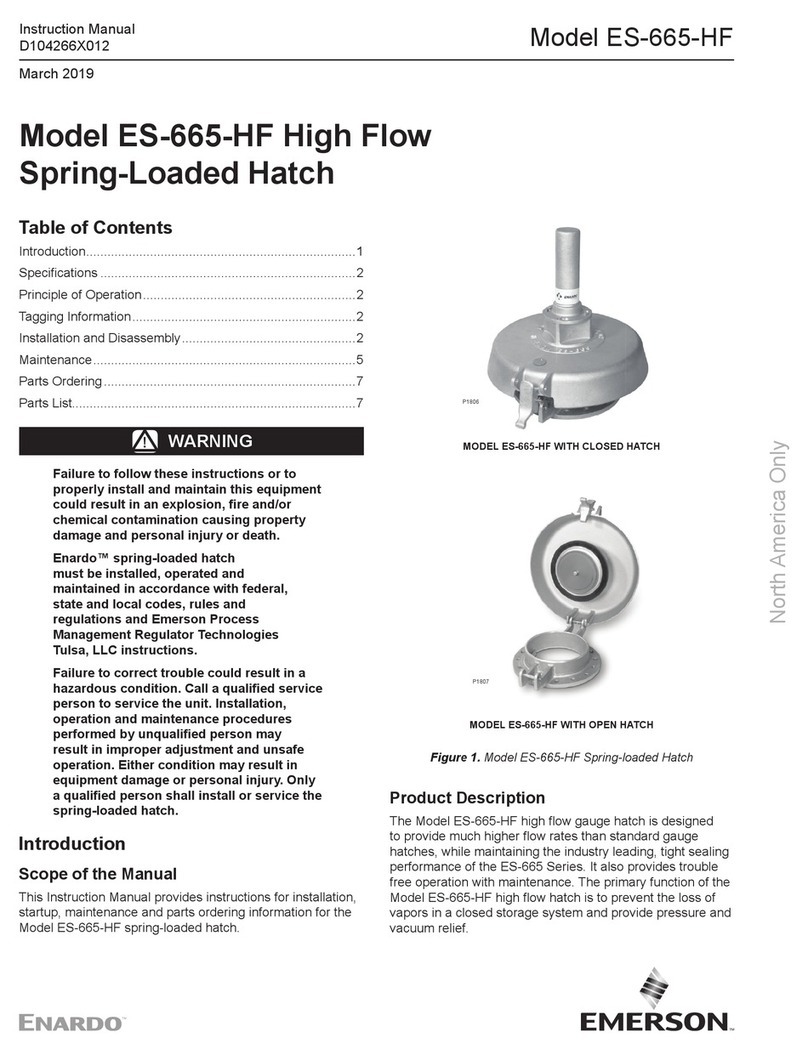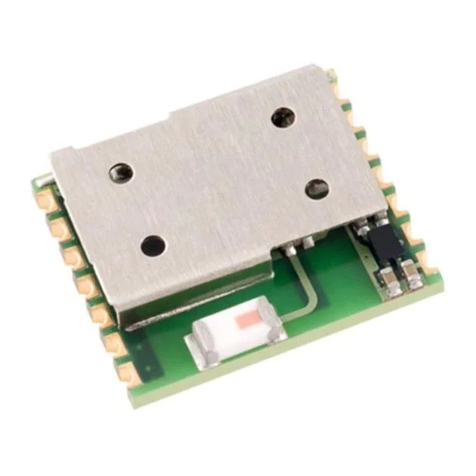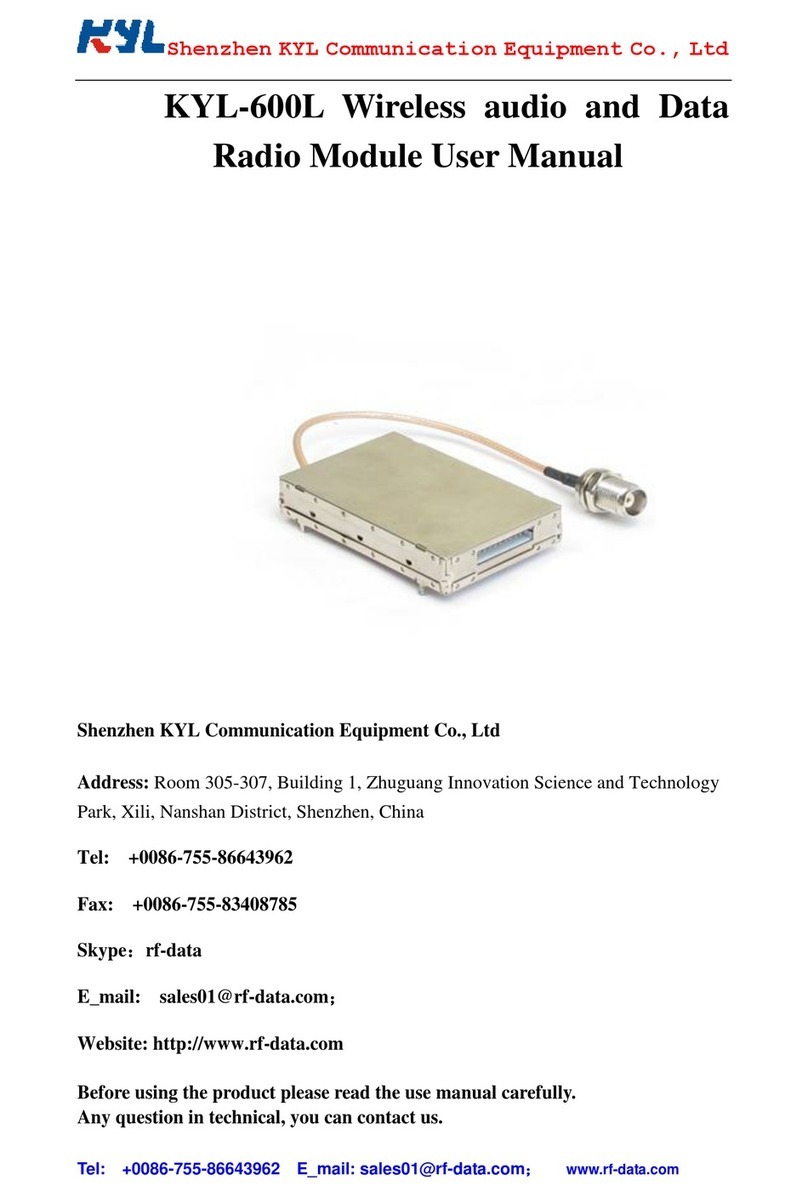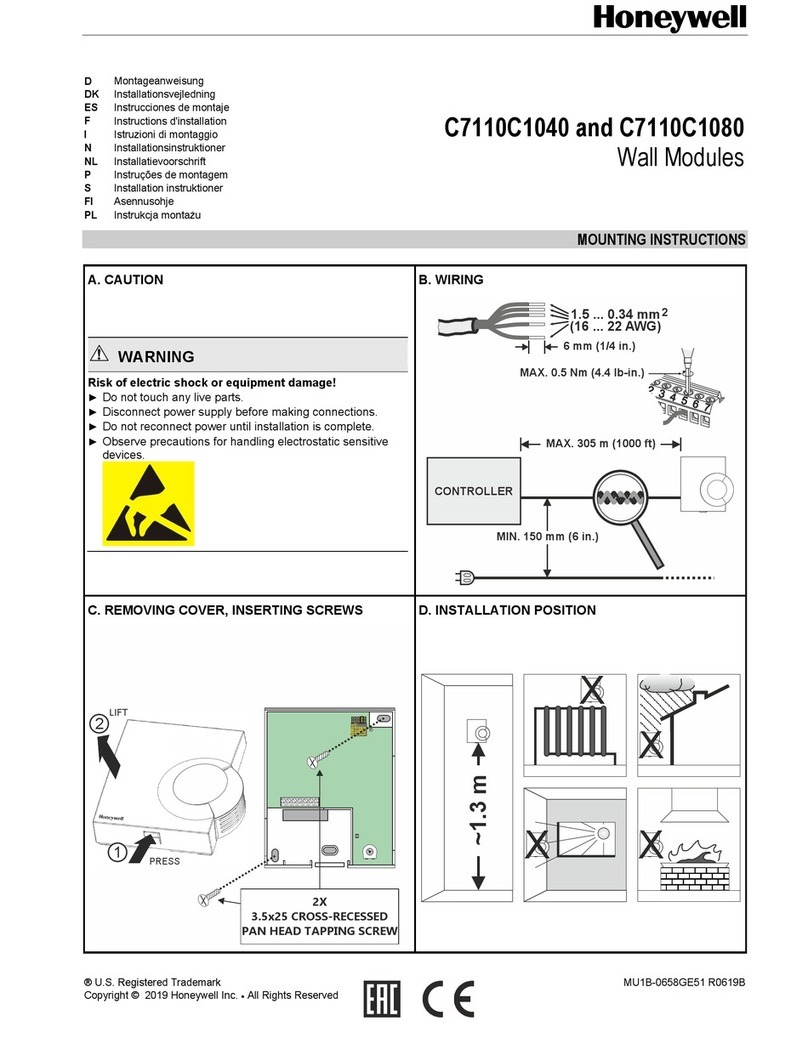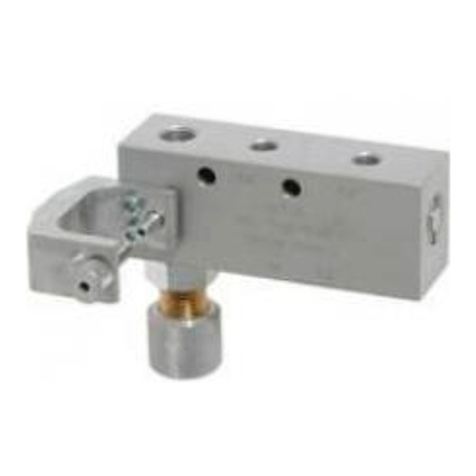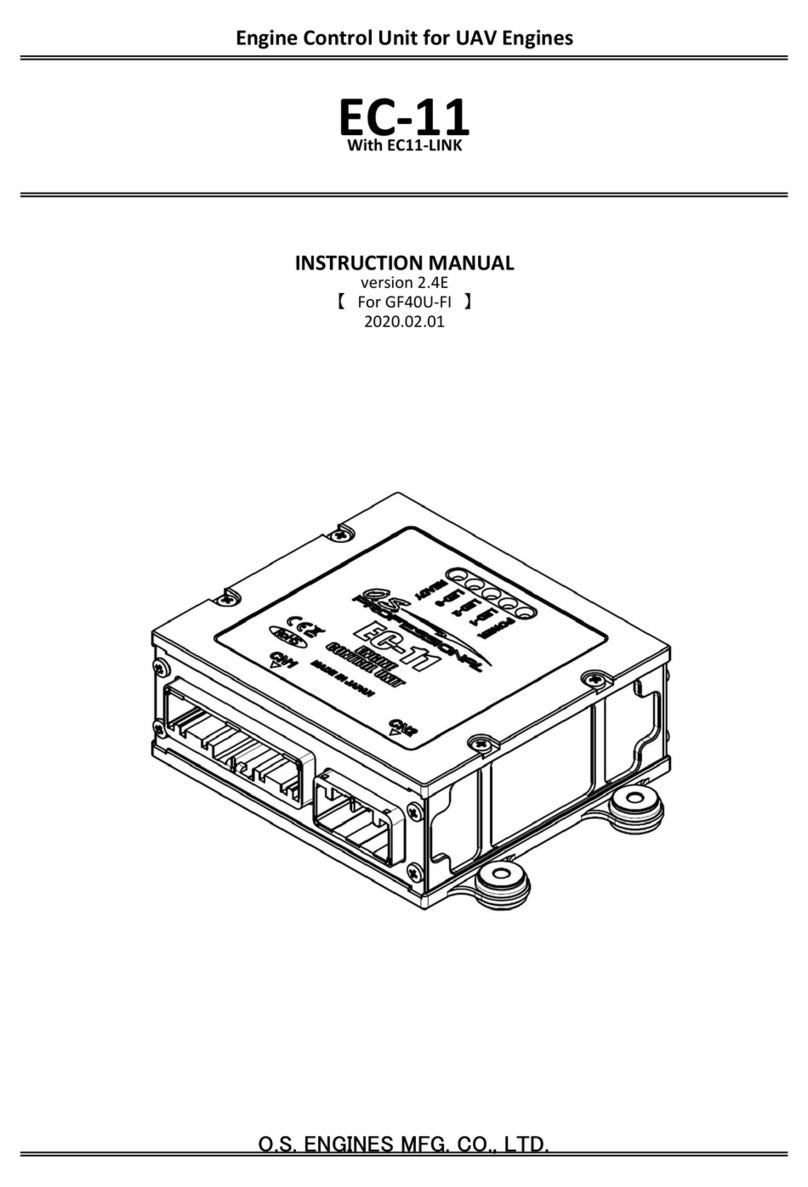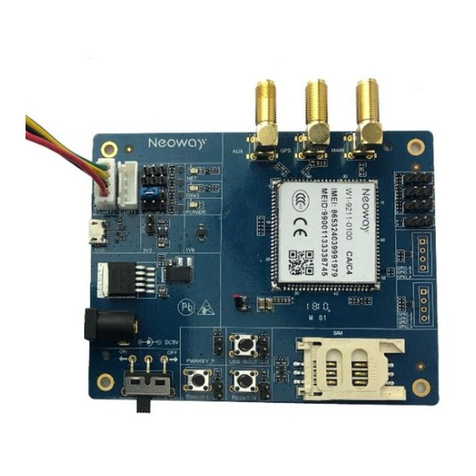tau K590M User manual

GUIDA ALL’INSTALLAZIONE
INSTALLATION GUIDE
INSTALLATIONSANLEITUNG
NOTICE D’INSTALLATION
GUÍA PARA LA INSTALACIÓN
GUIA DE INSTALAÇÃO
IT - Istruzioni originali
K590M
1 2 3 4 5 6 7 8 9 10
K590M
M5
SM
D-MNL0K590M 28-05-2021 - Rev.01 Ver. Firmware 8.xx

2
FR
SENS
TCA
12
13
14
15
16
17
18
19
20
21
22
1
2
3Neutral
230 Vac
Power supply
Phase
M-OP
ENC
AUX
FC
FS2
FS1
M-COM
M-CL
CH2
CH1
PROG
F1
3,15A
F2
500mA
DL1V
DL1R
DL2
DL3
DL4
DL5
DL6
DL7
DL8
DL9
4
5
6
7
8
9
10
11
1 2 3 4 5 6 7 8 9 10 11 12
1 2 3 4 5 6 7 8 9 10 11 12
Open/Close
Pedestrian
Stop
Common
Open
Gate open warning
light max. 3W
2nd radio
channel
K590M
Dip-switchesON
M1
M5
SM
M4
M2
M3
TCA
+-
SENS
+-
FR
+-
Photocells
Photocell (N.C.)
Photocell TX
Fixed safety edge
Common
RX
12345
TX
1 2
0 Vac
Signal
GND
+ VLED
- VLED
Photocell RX - 24 Vac
Trimmer:
Lamp
(VLED)
DL1R
DL1V
DL2
DL3
DL4
DL5
DL6
ERRORS - RADIO
RECEIVERS
OPEN
OPEN/CLOSE
PEDESTRIAN
STOP
FIXED SAFETY EDGE
DL7 PHOTO
DL8 FCA
DL9 FCC
LEDs:
SCHEMA
CABLAGGIO
K590M
K590M
WIRING
DIAGRAM
SCHALTPLAN
DER K590M
SCHÉMA
CÂBLAGE
K590M
ESQUEMA DEL
CABLEADO
K590M
ESQUEMA
DE LIGAÇÕES
K590M

3
FR
SENS
TCA
12
13
14
15
16
17
18
19
20
21
22
1
2
3Neutral
230 Vac
Power supply
Phase
M-OP
ENC
AUX
FC
FS2
FS1
M-COM
M-CL
CH2
CH1
PROG
F1
3,15A
F2
500mA
DL1V
DL1R
DL2
DL3
DL4
DL5
DL6
DL7
DL8
DL9
4
5
6
7
8
9
10
11
1 2 3 4 5 6 7 8 9 10 11 12
1 2 3 4 5 6 7 8 9 10 11 12
Open/Close
Pedestrian
Stop
Common
Open
Gate open warning
light max. 3W
2nd radio
channel
K590M
Dip-switchesON
M1
M5
SM
M4
M2
M3
TCA
+-
SENS
+-
FR
+-
Photocells
Photocell (N.C.)
Photocell TX
Fixed safety edge
Common
RX
12345
TX
1 2
0 Vac
Signal
GND
+ VLED
- VLED
Photocell RX - 24 Vac
Trimmer:
Lamp
(VLED)
DL1R
DL1V
DL2
DL3
DL4
DL5
DL6
ERRORS - RADIO
RECEIVERS
OPEN
OPEN/CLOSE
PEDESTRIAN
STOP
FIXED SAFETY EDGE
DL7 PHOTO
DL8 FCA
DL9 FCC
LEDs:

4
AVVERTENZE
Il presente manuale è destinato solamente al personale tecnico quali cato per l’installazione.
Nessuna informazione contenuta nel presente fascicolo può essere considerata d’interesse per l’utilizzatore
nale. Questo manuale è allegato alla centralina K590M, non deve pertanto essere utilizzato per prodotti
diversi!
Avvertenze importanti:
Togliere l’alimentazione di rete alla scheda prima di accedervi.
La centralina K590M è destinata al comando di un motoriduttore elettromeccanico per l’automazione di can-
celli, porte e portoni.
Ogni altro uso è improprio e, quindi, vietato dalle normative vigenti.
È nostro dovere ricordare che l’automazione che state per eseguire, è classi cata come “costruzione di una
macchina” e quindi ricade nel campo di applicazione della direttiva europea 2006/42/CE (Direttiva Macchine).
Questa, nei punti essenziali, prevede che:
- l’installazione deve essere eseguita solo da personale qualicato ed esperto;
- chi esegue l’installazione dovrà preventivamente eseguire “l’analisi dei rischi” della macchina;
- l’installazione dovrà essere fatta a “regola d’arte”, applicando cioè le norme;
- inne dovrà essere rilasciata al proprietario della macchina la”dichiarazione di conformità”.
Risulta chiaro quindi che l’installazione ed eventuali interventi di manutenzione devono essere eettuati solo
da personale professionalmente qualicato, in conformità a quanto previsto dalle leggi, norme o direttive
vigenti.
Nella progettazione delle proprie apparecchiture, TAU rispetta le normative applicabili al prodotto (vedere
la dichiarazione di conformità allegata); è fondamentale che anche l’installatore, nel realizzare gli impianti,
prosegua nel rispetto scrupoloso delle norme.
Personale non qualicato o non a conoscenza delle normative applicabili alla categoria dei “cancelli e porte
automatiche” deve assolutamente astenersi dall’eseguire installazioni ed impianti.
Chi non rispetta le normative è responsabile dei danni che l’impianto potrà causare!
Si consiglia di leggere attentamente tutte le istruzioni prima di procedere con l’installazione.
INSTALLAZIONE
Prima di procedere assicurarsi che il cancello si apra e si chiuda facilmente senza impedimen-
ti meccanici di alcun tipo. Vericare inoltre che il gruppo motoriduttore sia stato installato
correttamente seguendo le relative istruzioni ed anche che la relativa cremagliera sia stata
installata sul cancello in modo da non creare impedimento meccanico durante l’apertura e la
chiusura.
L’INSTALLAZIONE DELL’APPARECCHIATURA DEVE ESSERE EFFETTUATA “A REGOLA D’ARTE” DA PERSO-
NALE QUALIFICATO COME DISPOSTO DAL D.M. 37/08.
Nota: si ricorda l’obbligo di mettere a massa l’impianto nonché di rispettare le normative sulla
sicurezza in vigore in ciascun paese.
LA NON OSSERVANZA DELLE SOPRAELENCATE ISTRUZIONI PUÒ PREGIUDICARE IL BUON FUNZIO-
NAMENTO DELL’APPARECCHIATURA E CREARE PERICOLO PER LE PERSONE, PERTANTO LA “CASA CO-
STRUTTRICE” DECLINA OGNI RESPONSABILITÀ PER EVENTUALI MAL FUNZIONAMENTI E DANNI DOVUTI
ALLA LORO INOSSERVANZA.
1. SCHEDA DI COMANDO PER UN MOTORE 230V AC
• LOGICA CON MICROPROCESSORE
• STATO DEGLI INGRESSI VISUALIZZATO DA LEDs
• PROTEZIONE INGRESSO LINEA CON FUSIBILE
• CIRCUITO DI LAMPEGGIO INCORPORATO
• RADIO RICEVITORE 433,92 MHz INTEGRATO A 2 CANALI (CH)
• TEMPO DI LAVORO FISSO A 120 sec.
• RILEVAMENTO AUTOMATICO DELLA FREQUENZA DI ALIMENTAZIONE (50 o 60 Hz)
• CONTROLLO DELLA COPPIA MOTORE E RILEVAMENTO OSTACOLI TRAMITE ENCODER
• FUNZIONE “RALLENTAMENTO” REGOLABILE IN APERTURA E IN CHIUSURA
ITALIANO

5
• DIAGNOSTICA DEL DIFETTO FUNZIONE VISUALIZZATO DA LED
• COMPATIBILITÁ CON L’APP TAUOPEN E TAUAPP
ATTENZIONE:
- non utilizzare cavi unilari (a conduttore unico), es. quelli citofonici, al ne di evitare inter-
ruzioni sulla linea e falsi contatti;
- non riutilizzare vecchi cavi preesistenti.
- In caso di lunghi tratti di cavi ( > 20 m) per i comandi N.A. / N.C. (es: APRE/CHIUDE, STOP, PE-
DONALE, ecc), al ne di evitare malfunzionamenti del cancello si renderà necessario disac-
coppiare i vari comandi mediante RELAYS oppure utilizzando il nostro dispositivo 750T-RELE.
2. COLLAUDO
A collegamento ultimato:
• I Leds verdi (dal 3 al 6) devono essere tutti accesi (corrispondono ciascuno ad un ingresso Normal-
mente Chiuso). Si spengono solo quando sono interessati i comandi ai quali sono associati.
• I Leds rossi dei comandi di apertura devono essere tutti spenti (corrispondono ciascuno ad un
ingresso Normalmente Aperto) si accendono solo quando sono interessati i comandi ai quali sono
associati; il led DL1V verde farà un lampeggio ogni 4 sec.
3. CARATTERISTICHE TECNICHE
Alimentazione scheda 230V AC - 50 Hz
Potenza nominale 400 W
Fusibile rapido protezione alimentazione ingresso 230V AC (F1 - 5x20) F 3,15 A
Tensione circuiti alimentazione motore 230V AC
Tensione alimentazione circuiti dispositivi ausiliari 24V AC
Fusibile rapido protezione ausiliari 24V AC (F2 - 5x20) F 500 mA
Temperatura di funzionamento -20 °C ÷ +55 °C
4. COLLEGAMENTI ALLA MORSETTIERA
Morsetti Funzione Descrizione
1 - 2 - 3 ALIMENTAZIONE ingresso ALIMENTAZIONE 230 Vac 50Hz (115 Vac 60 Hz).
1= FASE, 2= TERRA, 3= NEUTRO;
4 - 8 APRE ingresso pulsante APRE (contatto Normalmente Aperto); (8= COMUNE - 4=
APRE)
5 - 8 APRE/CHIUDE ingresso pulsante APRE/CHIUDE (contatto Normalmente Aperto); (8= CO-
MUNE - 5= APRE/CHIUDE)
6 - 8 PEDONALE ingresso pulsante PEDONALE (contatto Normalmente Aperto);
Nota: l’automazione è programmata per eettuare un’apertura pe-
donale pari ad un terzo della corsa totale. (8= COMUNE - 6= PEDONALE)
7 - 8 STOP ingresso pulsante STOP (contatto Normalmente Chiuso); (8= COMUNE -
7= STOP)
9 - 10 BORDO
SENSIBILE
ingresso BORDO SENSIBILE (Bordo sensibile con contatto resistivo o N.C.);
Durante la fase di apertura provoca l’ arresto temporaneo del cancello
e una parziale richiusura dello stesso per circa 20 cm liberando così l’e-
ventuale ostacolo. Durante la fase di chiusura provoca l’arresto seguito
dalla totale riapertura del cancello. In questo caso, se programmata verrà
inibita la chiusura automatica. Ponticellare i morsetti se non utilizzati. (9=
COMUNE - 10= BORDO SENSIBILE)
Se si collega un bordo sensibile resistivo 8K2 Ohm porre il dip-switch
nr 12 in ON;
Se si collega un bordo sensibile con contatto NC porre il dip-switch
nr 12 in OFF;
ITALIANO

6
9 - 11 FOTOCELULE
ingresso FOTOCELLULE O DISPOSITIVI DI SICUREZZA attivi in chiusura
(contatto Normalmente Chiuso); il loro intervento, in fase di chiusura pro-
voca l’arresto seguito dalla totale riapertura del cancello, in fase di apertu-
ra provoca la fermata temporanea del cancello no a rimozione dell’osta-
colo rilevato (solo se programmato dip switch nr. 3 in ON). Nel caso di più
dispositivi di sicurezza, collegare tutti i contatti NC IN SERIE.
(9= COMUNE - 11= FOTOCELLULE)
Nota: Il trasmettittore della fotocellula deve sempre essere alimen-
tato dai morsetti nr 18 - 16, in quanto su di esso si eettua la veri-
ca del sistema di sicurezza (Fototest). Per eliminare la verica del
sistema di sicurezza, o quando non si usano le fotocellule, porre il
dip-switch nr 6 in OFF. Se il fototest non va a buon ne, la centralina
non funziona;
12 - 13 2° CANALE
RADIO
uscita 2° CANALE RADIO da utilizzarsi per aprire/chiudere un altro cancel-
lo o per comandare le luci del giardino, o per la funzione “ILLUMINAZIONE
DI ZONA” (da programmare tramite TauApp);
Nota: per il collegamento di altri dispositivi al 2° canale radio, quali
accensione luci, comando pompe o carichi importanti, utilizzare un
relè ausiliario di potenza con portata adeguata ai dispositivi da col-
legare, altrimenti si potrebbero avere malfunzionamenti dovuti a
disturbi indotti.
14 - 15 SPIA CANCELLO
APERTO
uscita per SPIA CANCELLO APERTO 24 Vac - max. 3 W; durante l’apertura
del cancello la spia lampeggia lentamente, a cancello aperto resta accesa
e durante la chiusura lampeggia a velocità doppia. 14= 0 Vac, 15= 24 Vac;
16 - 18 TX
FOTOCELLULA
uscita 24 Vac 10 W per l’ALIMENTAZIONE DEL TX DELLE FOTOCELLULE
(solo quello che eettua il Fototest) max. nr. 1 trasmettitore fotocellule.
18= 0 Vac, 16= 24 Vac;
17 - 18 RX
FOTOCELLULE
uscita 24 Vac 10 W per l’ALIMENTAZIONE DELLE RX ED EVENTUALI ALTRI
TX DELLE FOTOCELLULE, RICEVITORI ESTERNI, etc; collegare max. n° 3
coppie di fotocellule. 18= 0 Vac, 17= 24 Vac;
19 - 20 LAMPEGGIANTE Uscita LAMPEGGIANTE LEDS 12Vdc, max 200mA (19 = negativo - 20 = po-
sitivo) Il segnale fornito è già opportunamente modulato per l’uso diretto.
La frequenza di lampeggio è doppia in fase di chiusura;
21 - 22 ANTENNA Ingresso antenna per RX 433,92 MHz integrata; 21= MASSA, 22= SEGNALE;
M1 FINE CORSA innesto rapido per connessione FINE CORSA (contatti Normalmente Chiu-
si). Arancio= FineCorsaChiusura (CLS), rosso= FineCorsaApertura (OLS),
grigio= Comune (COM);
M2 ENCODER innesto rapido per connessione ENCODER. Blu= 0 Vcc (GND), marrone= 5
Vcc (+5V), bianco= SEGNALE ENCODER (ENC);
FS1 - FS2 CONDENSATORE faston per connessione CONDENSATORE del motore;
M3 MOTORE
230V AC innesto rapido per connessione MOTORE monofase 230 Vac comune= BLU
(M-COM); fase chiusura= MARRONE (M-CL); fase apertura= NERO (M-OP).
M4 AUX Innesto rapido per connessione dispositivi T-WIFI e T-CONNECT
M5 SCHEDA MEMORIA innesto rapido per connessione SCHEDA DI MEMORIA per codici radioco-
mandi.
ITALIANO

7
ITALIANO
5. REGOLAZIONI LOGICHE
TRIMMER
FR. Regolazione coppia motore. Regolare il trimmer per una spinta del cancello atta a garan-
tire il funzionamento, facendo attenzione a non superare quella consentita dalle norme
in uso (EN 12453). Ruotando il trimmer in senso orario (+) si aumenta la coppia motore,
viceversa, ruotandolo in senso antiorario (-), diminuisce.
SENS utilizzato solo con ENCODER attivo (dip 11 ON).
Regolazione riferimento aggiuntivo per rilevamento ostacoli;
NOTA: ruotando il TRIMMER SENS in senso orario si diminuisce la sensibilità del
motoriduttore sull’ostacolo e quindi aumenta la forza di spinta; viceversa, ruotan-
dolo in senso antiorario, aumenta la sensibilità del motoriduttore sull’ostacolo e
diminuisce la forza di spinta.
ATTENZIONE: con il trimmer al max. il rilevamento ostacoli è disabilitato!!
T.C.A. Regolazione tempo di richiusura automatica da 5 a 120 secondi.
DIP SWITCH
1CHIUSURA
AUTOMATICA
On ad apertura completata, la chiusura del cancello è automatica trascor-
so un tempo impostato sul trimmer T.C.A.;
O la chiusura necessita di un comando manuale;
22 / 4 TEMPI
On ad automazione funzionante, una sequenza di comandi di apertura/
chiusura induce il cancello ad una APERTURA-CHIUSURA-APERTURA-
CHIUSURA, etc. (vedi anche dip switch 4);
O nelle stesse condizioni, la stessa sequenza di comandi di apertura/
chiusura induce il cancello ad una APERTURA-STOP-CHIUSURA-STOP-
APERTURA-STOP, etc. (funzione passo-passo);
3INTERVENTO
FOTOCELLULE
IN APERTURA
On durante la fase di apertura la fotocellula interviene arrestando il can-
cello no a rimozione dell’ostacolo rilevato. Alla rimozione dell’ostacolo
il cancello riprende l’apertura;
O durante la fase di apertura la fotocellula non interviene;
4NO REVERSE
On funzione NO-REVERSE attiva; il cancello ignora i comandi di chiusura
durante l’apertura e l’inversione di marcia avviene solo in fase di chiu-
sura;
O azionando il pulsante apre-chiude avremo una inversione di marcia
anche in fase di apertura;
5PRE-
LAMPEGGIO
On la funzione prelampeggio è abilitata;
O la funzione prelampeggio è disabilitata;
6FOTOTEST
On la funzione “verica delle fotocellule” è inserita;
O la funzione “verica delle fotocellule” è disinserita.
Nota: da utilizzare quando non si usano le fotocellule;
7INGRESSO PEDO-
NALE
On la funzione cambia in solo chiusura cancello. Il contatto N.A. 6-8 da
Pedonale diventa Chiude (contatto normalmente aperto)
O “apertura / chiusura” Pedonale; (contatto normalmente aperto)
8UOMO PRESENTE On Funzione uomo presente attiva per i pulsanti APRE e CHIUDE (mors.
4-8 e 6-8 con dip switch 7 in ON);
O Funzione uomo presente non attiva;
9TIPO
CANCELLO
On settaggio per cancelli pesanti o particolarmente dicili da aprire e
chiudere
O settaggio per cancelli normali
10 SELEZIONE
VERSO APERTURA
On funzionamento per anta con apertura verso destra (lato operatore);
O funzionamento per anta con apertura verso sinistra (lato operatore);

8
11
ENCODER On ENCODER inserito: funzione rilevamento ostacoli tramite encoder atti-
va (agire sui trimmer FR e SENS per regolare la sensibilità sull’ostacolo);
O ENCODER escluso - nessun rilevamento ostacoli;
NOTA: se il dip 11 viene spostato da ON ad OFF o viceversa, la corsa memorizzata
in precedenza viene annullata ed è necessario ripetere la procedura di setup.
12 BORDO
SENSIBILE
On BORDO SENSIBILE RESISTIVO 8K2 Ohm (morsetto nr 11);
O COSTA FISSA (contatto NC - morsetto nr 11).
RILEVAMENTO OSTACOLI (dip 11 ON)
La funzione di rilevamento ostacoli (impostabile tramite i trimmer FR e SENS) intervenendo in fase di
apertura dell’automazione provoca una richiusura della stessa di 20 cm ca., mentre in fase di chiusura
provoca un’apertura totale.
ATTENZIONE: la logica del quadro di comando può interpretare un attrito meccanico
come un eventuale ostacolo.
6. PROCEDURA DI IMPOSTAZIONE DELLA CORSA CON O SENZA RALLENTA-
MENTO (SETUP)
ATTENZIONE: la procedura di impostazione della corsa si deve eettuare sempre, anche
se non si utilizza l’encoder (dip 11 OFF).
È preferibile iniziare la procedura con l’automazione già sul necorsa di chiusura FCC.
Premere il tasto PROG e mantenerlo premuto no a che i led DL1R e DL1V iniziano a lampeggiare ve-
locemente. Dopo averlo rilasciato al procedura esegue i seguenti passi:
1_ Se l’automazione è già sul necorsa FCC passa direttamente al punto 2.
Diversamente se l’automazione non è sul FCC parte alla ricerca del ne corsa in chiusura;
Se l’automazione apre anzichè chiudere, fermare la corsa del cancello (tramite fotocellule
o aprendo il contatto STOP), invertire il dip 10 e premere il tasto PROG per riprendere la
procedura.
2_ L’automazione parte alla misurazione della corsa dal FCC no al ncorsa in apertura FCA ;
ATTENZIONE: durante l’apertura premere il tasto PROG o chiudere il contatto APRE/
CHIUDE nel punto in cui si desidera far iniziare il rallentamento (se non viene premuto
PROG o chiuso il contatto APRE/CHIUDE, non si avrà nessun rallentamento).
3_ teminata l’apertura l’automazione parte alla misurazione della corsa dal necorsa in apertura FCA
al ncorsa in chiusura FCC
IMPOSTAZIONE DEL RALLENTAMENTO: durante la chiusura premere il tasto PROG o chiu-
dere il contatto APRE/CHIUDE nel punto in cui si desidera far iniziare il rallentamento (se
non viene premuto PROG o chiuso il contatto APRE/CHIUDE, non si avrà nessun rallen-
tamento).
4_ La procedura è completata, il led DL1V verde farà un lampeggio ogni 4 sec.
ATTENZIONE: se durante il setup si apre il contatto STOP o FOTOCELLULE oppure BORDO
SENSIBILE, il cancello si ferma. Premendo il pulsante PROG o chiudendo il contatto APRE/
CHIUDE la procedura riparte dal punto 1.
7. RADIO RICEVITORE 433,92 MHz INTEGRATO
Il radio ricevitore può apprendere no ad un max di 30 codici rolling code (S-2RP, S-4RP, K-SLIM-RP,
T-4RP) da impostare liberamente su due canali.
Il primo canale comanda direttamente la scheda di comando per l’apertura dell’automazione; il secon-
do canale comanda un relè per un contatto pulito N.A. in uscita ai morsetti nr 12 e 13 (max 24V AC, 1 A).
APPRENDIMENTO RADIOCOMANDI
CH1 = 1° canale (APRE/CHIUDE) CH2 = 2° canale CH3 = 3° canale (PEDONALE)
1_ Premere brevemente il tasto CH1 se si desidera associare un radiocomando alla funzione APRE/
CHIUDE;
ITALIANO

9
2_ Il led DL1V (verde) si accende sso per indicare la modalità di apprendimento dei codici (se non
viene immesso nessun codice entro 10 secondi, la scheda esce dalla modalità di programmazione);
3_ Premere il tasto del radiocomando che si desidera utilizzare;
4_ Il led DL1V (verde) si spegne per segnalare l’avvenuta memorizzazione e si riaccende subito in at-
tesa di altri radiocomandi (se ciò non accade, provare a ritrasmettere oppure attendere 5 secondi
e riprendere dal punto 1);
5_ Se si desidera memorizzare altri radiocomandi, premere il tasto da memorizzare sugli altri dispo-
sitivi entro 5 sec. Passato questo lasso di tempo (il led verde DL1V si spegne) è necessario ripetere
la procedura dal punto 1 (no ad un massimo di 30 trasmettitori);
6_ Se si desidera eettuare la memorizzazione sul 2° canale, ripetere la procedura dal punto 1 utiliz-
zando il tasto CH2 anzichè il tasto CH1 (in questo caso i led rosso/verde DL1e DL1V si accenderan-
no);
7_ se si desidera eettuare la memorizzazione sul 3° canale, ripetere la procedura dal punto 1 utilizzando
contemporaneamente i tasti CH1 e CH2 (in questo caso il led rosso DL1R si accenderà);
Nel caso di raggiungimento del nr massimo di radiocomandi (nr 30), il led DL1V (ver-
de) per il CH1 ed il led DL1R (rosso) per il CH2 lampeggiano per circa 3 secondi senza
però eseguire la memorizzazione.
PROGRAMMAZIONE REMOTA TRAMITE T-4RP e K-SLIM-RP / S-2RP / S-4RP (V 4.X)
Con la versione di software V 4.X è possibile eseguire l’apprendimento remoto con i radiocomandi
T-4RP / K-SLIM-RP / S-2RP / S-4RP (V 4.X), ossia senza agire direttamente sui tasti di programmazione
della ricevente.
Sarà suciente disporre di un radiocomando già programmato nella ricevente per poter aprire la
procedura di programmazione remota dei nuovi radiocomandi. Seguire la procedura riportata sulle
istruzioni del radiocomando T-4RP / K-SLIM-RP / S-2RP / S-4RP (V 4.X).
CANCELLAZIONE RADIOCOMANDI
1_ Tenere premuto per 3 secondi ca. il tasto CH1 al ne di cancellare tutti i radiocomandi ad esso
associati;
2_ Il led verde DL1V inizia a lampeggiare lentamente per indicare che la modalità di cancellazione è
attivata;
3_ tenere premuto nuovamente il tasto CH1 per 3 secondi;
4_ Il led verde DL1V si spegne per 3 secondi ca. per poi riaccendersi sso ad indicare l’avvenuta can-
cellazione;
5_ Riprendere la procedura dal punto 1 utilizzando il tasto CH2 per cancellare tutti i radiocomandi ad
esso associati;
6_ riprendere la procedura dal punto 1 utilizzando contemporaneamente i tasti CH1 e CH2 per can-
cellare tutti i radiocomandi associati al 3° canale;
7_ Se si desidera uscire dalla modalità di cancellazione senza memorizzare un codice, premere breve-
mente il tasto CH1 o il tasto CH2.
MEMORIA CODICI
È possibile espandere la memoria dei codici da 30 * a 126, 254 o 1022, utilizzando le schede di memo-
ria come indicato (innestandole nel connettore M5 vedi schema cablaggio):
126 codici Art. 250SM126
254 codici Art. 250SM254
1022 codici Art. 250SM1022
* Le centrali, di serie, hanno una memoria di 30 codici. La scheda per la maggiorazione deve essere
ordinata a parte.
Per permettere lo spostamento dei codici già precedentemente memorizzati nella centrale (max. 30)
si renderà necessario installare una scheda di memoria facendo attenzione che la centrale sia in quel
momento spenta e che la scheda di memoria sia nuova di fabbrica e quindi completamente vuota.
Una volta inserita la nuova scheda di memoria alla riaccensione della centrale i codici si sposteranno
automaticamente nella stessa.
ITALIANO

10
Lo spostamento dei codici da centrale a scheda di memoria non funziona nel caso in cui si uti-
lizzi una scheda di memoria sulla quale siano già stati memorizzati codici radiocomando e che
sia stata cancellata succesivamente.
Per inserire nuovi radiocomandi si ripeterà l’operazione descritta precedentemente.
ATTENZIONE: nel momento in cui si innesta/toglie una scheda di memoria, la centrale
deve essere spenta.
RESET MEMORIA RADIO:
- tenere premuti i tasti CH1 e PROG no a che i led DL1R (rosso) rimane acceso sso e DL1V (verde)
inizia a lampeggiare velocemente. A questo punto, rilasciare i tasti e premerli nuovamente no a
che i led si spengono, a conferma che l’operazione è terminata.
RESET DI FABBRICA:
- tenere premuti i tasti CH2 e PROG no a che il led DL1R inizia a lampeggiare velocemente in rosso.
A questo punto, rilasciare i tasti e premerli nuovamente no a che il led si spengne (reset in corso),
a conferma che l’operazione è terminata. Alla ripartenza, sarà necessario eseguire la procedura di
memorizzazione.
Eettuando un reset di fabbrica la memoria radio rimane invariata, pertanto i radio-
comandi esistenti rimangono memorizzati.
8. FUNZIONI AVANZATE
Funzione orologio: è possibile utilizzare un timer (esempio settimanale) collegato all’ingresso del pul-
sante apre-chiude per mantenere aperto il cancello in determinate fascie orarie e permetterne poi la
richiusura automatica.
Nota: il cancello rimane aperto nchè l’ingresso Ap/Ch rimane impegnato.
9. LED DI DIAGNOSI
DL1V (verde) + DL1R
(rosso) Led di segnalazione programmazione RADIOCOMANDI, ERRORI e
dello stato della centrale di comando;
DL2 - Rosso Led di segnalazione pulsante APRE;
DL3 - Rosso Led di segnalazione pulsante APRE/CHIUDE;
DL4 - Rosso Led di segnalazione pulsante PEDONALE;
DL5 - Verde Led di segnalazione pulsante STOP;
DL6 - Verde Led di segnalazione BORDO SENSIBILE.
DL7 - Verde Led di segnalazione FOTOCELLULA
DL8 - Verde Led di segnalazione FINE CORSA DI APERTURA (FCA);
DL9 - Verde Led di segnalazione FINE CORSA DI CHIUSURA (FCC);
LED: DL1V (verde) + DL1R (rosso)
I led DL1R e DL1V segnalano eventuali errori con una serie di lampeggi predeniti:
Legenda: led acceso sso; led lampeggiante; led spento;
/ Lampeggio alternato (Rosso/
Verde): Memorizzazione da eseguire;
/ Lampeggio di entrambi veloce
(Rosso/Verde): Memorizzazione in corso;
/ 1 lampeggio ogni 4 sec. Stato della posizione sconosciuta - Prossima manovra
RIALLINEAMENTO
/ Nr. 8 lampeggi intervallati da
una pausa di 1 sec. (Rosso/Verde): Errore dati in Eeprom;
Eseguire procedura di reset memoria Radio;
ITALIANO

11
LED: DL1V (verde) + DL1R (rosso sempre spento)
1 Lampeggio ogni 4 sec. (Verde): Funzionamento regolare;
1 lampeggio ogni 1 sec (lampeggio
continuo) Memoria Radio della scheda viene letta dal TAUSOFT
Sempre acceso (Verde): Canale CH1 in attesa di programmazione;
Lampeggio veloce (Verde): Memoria CH1 piena;
Lampeggio (Verde): Canale CH1 in attesa di cancellazione;
Spento: Canale CH1 in cancellazione
LED: DL1V (verde sempre spento) + DL1R (rosso)
Spento: Funzionamento regolare;
1 Lampeggio ogni 1 sec (Rosso): Errore fototest;
Disabilitare fototest (DIP-SWITCH 6 in OFF), verifare funziona-
mento fotocellule e il loro collegamento;
2 Lampeggi intervallati da una pau-
sa di 1 sec.(Rosso): Presenza ostacolo motore;
Controllare l’assenza di ostacoli lungo la corsa del cancello e la
scorrevolezza dello stesso;
3 Lampeggi intervallati da una pau-
sa di 1 sec.(Rosso): Encoder guasto o scollegato da M1
Controllare cablaggio, vericare encoder tramite TEST-ENCODER
(opzionale);
6 lampeggi intervallati da una
pausa di 1 sec.
Raggiunto n. max tentativi di chiusura automatica falliti
Presenza ostacolo (solo con dip 11 ON);
Controllare l’assenza di ostacoli lungo la corsa del cancello e la
scorrevolezza dello stesso;
7 lampeggi intervallati da una pau-
sa di 1 sec. (Rosso): Intervento sicurezza bordo sensibile
È necessario un impulso di comando per effettuare la chiu-
sura;
8 Lampeggi intervallati da una pau-
sa di 1 sec.(Rosso): Errore memoria Eeprom esterna;
Sostituire il modulo di memoria esterna;
10. PREDISPOSIZIONE AL FUNZIONAMENTO CON LE APPLICAZIONI TAU
Per poter utilizzare le applicazioni TauApp e TauOpen si renderà necessario collegare all’ingresso M4
della centrale mediante il cavo in dotazione i rispettivi dispositivi T-WIFI e T-CONNECT.
Per attivare il funzionamento delle applicazioni vedere le rispettive istruzioni.
11. RIPRISTINO FUNZIONAMENTO AUTOMATICO
Qualora si renda necessario movimentare manualmente la chiusura o l’apertura del cancello, azionare
lo sblocco manuale. Per ripristinare il normale funzionamento (in automatico), occorre specicare:
Se il ripristino avviene successivamente ad un black-out, oppure dopo un intervento manuale, prima
di alimentare nuovamente la scheda è necessario porre il cancello in posizione totalmente aperto o
totalmente chiuso.
ITALIANO

12
12. MALFUNZIONAMENTI: POSSIBILI CAUSE E RIMEDI
L’automazione non parte
a_ Vericare con lo strumento (Multimetro) la presenza dell’alimentazione 230Vac;
b_ Vericare che i contatti N.C. della scheda siano eettivamente normalmente chiusi (5 led verdi
accesi) e che i led rossi dei comandi di apertura siano spenti;
c_ Vericare che il led verde DL1V faccia un lampeggio ogni 4 sec;
d_ Impostare il dip 6 (fototest) su OFF;
e_ Controllare con lo strumento (Multimetro) che i fusibili siano integri.
Il radiocomando ha poca portata
a_ Controllare che il collegamento della massa e del segnale dell’antenna non sia invertito;
b_ Non eseguire giunzioni sul cavo dell’antenna;
c_ Non installare l’antenna in posizioni basse o in posizioni nascoste dalla muratura o dal pilastro;
d_ Controllare lo stato delle pile del radiocomando.
Il cancello si apre al contrario
a_ Invertire la posizione del dip-switch nr. 10, dopo aver tolto l’alimentazione al quadro di comando.
13. GARANZIA: CONDIZIONI GENERALI
La garanzia della TAU ha durata di 24 mesi dalla data di acquisto dei prodotti (fa fede il documento
scale di vendita, scontrino o fattura).
La garanzia comprende la riparazione con sostituzione gratuita (franco sede TAU: spese di imballo e di
trasporto sono a carico del cliente) delle parti che presentano difetti di lavorazione o vizi di materiale
riconosciuti dalla TAU.
In caso di intervento a domicilio, anche nel periodo coperto da garanzia, l’utente è tenuto a corrispon-
dere il “Diritto sso di chiamata” per spese di trasferimento a domicilio, più manodopera.
La garanzia decade nei seguenti casi:
• Qualora il guasto sia determinato da un impianto non eseguito secondo le istruzioni fornite
dall’azienda all’interno di ogni confezione.
• Qualora non siano stati impiegati tutti componenti originali TAU per l’installazione
dell’automatismo.
• Qualora i danni siano causati da calamità naturali, manomissioni, sovraccarico di tensione,
alimentazione non corretta, riparazioni improprie, errata installazione, o altre cause non im-
putabili alla TAU.
• Qualora non siano state eettuate le manutenzioni periodiche da parte di un tecnico specializ-
zato secondo le istruzioni fornite dall’azienda all’interno di ogni confezione.
• Usura dei componenti.
La riparazione o la sostituzione dei pezzi durante il periodo di garanzia non comporta un prolunga-
mento del termine di scadenza della garanzia stessa.
In caso di utilizzo industriale o professionale oppure in caso di impiego simile, tale garanzia ha validità
12 mesi.
ITALIANO

13
DICHIARAZIONE DI INCORPORAZIONE DEL COSTRUTTORE
(ai sensi della Direttiva Europea 2006/42/CE AlI. II.B)
Fabbricante: TAU S.r.l.
Indirizzo: Via E. Fermi, 43 - 36066 Sandrigo (Vi) - ITALIA
Dichiara sotto la propria responsabilità che il prodotto: Centrale di comando
realizzato per il movimento automatico di: Cancelli Scorrevoli
per uso in ambiente: Residenziale / Condominiale
completo di: Radioricevente
Modello: K590M
Tipo: K590M
Numero di serie: vedi etichetta argentata
Denominazione commerciale: Quadro di comando per motoriduttore
T-ONE5, T-ONE8, T-ONEXL e MASTER20QR/QM
È realizzato per essere incorporato su una chiusura (cancello scorrevole) o per essere assemblato con altri dispositivi
al ne di movimentare una tale chiusura per costituire una macchine ai sensi della Direttiva Macchine 2006/42/CE.
Dichiara inoltre che questo prodotto è conforme ai requisiti essenziali di sicurezza delle seguenti ulteriori direttive CEE:
- 2014/35/EU Direttiva Bassa Tensione - 2014/30/EU Direttiva Compatibilità Elettromagnetica
ed, ove richiesto, alla Direttiva: -2014/53/EU Apparecchiature Radio e apparecchiature terminali di telecomunicazione
Dichiara inoltre che non è consentito mettere in servizio il macchinario no a che la macchina in cui sarà
incorporato o di cui diverrà componente sia stata identicata e ne sia stata dichiarata la conformità alle condizioni
della Direttiva 2006/42/CE.
Sono applicate le seguenti norme e speciche tecniche:
EN 61000-6-2; EN 61000-6-3; EN 60335-1; ETSI EN 301 489-1 V1.9.2; ETSI EN 301 489-3 V1.6.1;
EN 300 220-2 V3.1.1; EN 12453:2000; EN 12445:2000; EN 60335-2-103.
Si impegna a trasmettere, su richiesta adeguatamente motivata delle autorità nazionali, informazioni pertinenti sulle
quasi-macchine.
Sandrigo, 31/10/2017 Il Rappresentante Legale
_________________________________________
Loris Virgilio Danieli
Nome e indirizzo della persona autorizzata a costituire la documentazione tecnica pertinente:
Loris Virgilio Danieli - via E. Fermi, 43 - 36066 Sandrigo (Vi) Italia
ITALIANO

14
WARNINGS
This manual has been especially written for use by quali ed tters. No information given in this manual
can be considered as being of interest to end users. This manual is enclosed with control unit K590M and
may therefore not be used for dierent products!
Important information:
Disconnect the panel from the power supply before opening it.
The K590M control unit has been designed to control an electromechanical gear motor for automating
gates and doors of all kinds.
Any other use is considered improper and is consequently forbidden by current laws.
Please note that the automation system you are going to install is classi ed as “machine construction”
and therefore is included in the application of European directive 2006/42/EC (Machinery Directive).
This directive includes the following prescriptions:
- Only trained and qualied personnel should install the equipment;
- the installer must rst make a “risk analysis” of the machine;
- the equipment must be installed in a correct and workmanlike manner in compliance with all the
standards concerned;
- after installation, the machine owner must be given the “declaration of conformity”.
This product may only be installed and serviced by qualied personnel in compliance with current, laws,
regulations and directives.
When designing its products, TAU observes all applicable standards (please see the attached declaration
of conformity) but it is of paramount importance that installers strictly observe the same standards when
installing the system.
Unqualied personnel or those who are unaware of the standards applicable to the “automatic gates
and doors” category may not install systems under any circumstances.
Whoever ignores such standards shall be held responsible for any damage caused by the system!
Do not install the unit before you have read all the instructions.
INSTALLATION
Before proceeding, make sure that the gate opens and closes easily without mechanical impedi-
ments of any kind. Also check that the gear motor assembly has been installed according to the
instructions and also that the relative rack has been installed on the gate so as not to create
mechanical obstacles during opening and closing.
THE EQUIPMENT MUST BE INSTALLED “EXPERTLY” BY QUALIFIED PERSONNEL AS REQUIRED BY LAW.
Note: it is compulsory to earth the system and to observe the safety regulations that are in
force in each country.
IF THESE ABOVE INSTRUCTIONS ARE NOT FOLLOWED IT COULD PREJUDICE THE PROPER WORKING
ORDER OF THE EQUIPMENT AND CREATE HAZARDOUS SITUATIONS FOR PEOPLE. FOR THIS REASON
THE “MANUFACTURER” DECLINES ALL RESPONSIBILITY FOR ANY MALFUNCTIONING AND DAMAGES
THUS RESULTING.
1. CONTROL PANEL FOR ONE 230V AC MOTOR
• MICROPROCESSOR-CONTROLLED LOGIC
• INPUT STATUS LED’S
• LINE INPUT FUSE
• BUILT-IN FLASHING LIGHT CIRCUIT
• 433.92 MHz 2 CHANNEL BUILT-IN RADIO RECEIVER (CH)
• OPERATING TIME FIXED AT 120 sec.
• AUTOMATIC DETECTION OF THE POWER SUPPLY FREQUENCY (50 or 60 Hz)
• MOTOR TORQUE CONTROL AND OBSTACLE DETECTION BY MEANS OF ENCODER
• ADJUSTABLE DECELERATION
• “SLOW-DOWN” FUNCTION IN OPENING AND IN CLOSING PHASE
• DIAGNOSTICS OF MALFUNCTIONS SIGNALLED BY LED
ENGLISH

15
ENGLISH
• COMPATIBILITY WITH OUR APPS: TAUOPEN AND TAUAPP
ATTENTION:
- do not use single cables (with one single wire), ex. telephone cables, in order to avoid break-
downs of the line and false contacts;
- do not re-use old pre-existing cables.
- In case of long sections of cables (> 20 m) for N.O./N.C. controls (e.g. OPEN / CLOSE, STOP, PEDE-
STRIAN, etc.), in order to avoid gate malfunctions, it will be necessary to uncouple the various
controls using RELAYS or using our 750T-RELE device.
2. TESTING
When you have completed the connection:
• All the green LEDs (from 3 to 6) must be on (each of them corresponds to a Normally Closed input).
They go o only when the controls to which they are associated are operated.
• The red opening command LEDs must all be unlit (each corresponding to a Normally Open input)
and illuminate only when the commands they are associated with are given; The green led DL1V
will ash every 4 seconds.
3. TECHNICAL CHARACTERISTICS
Power input to board 230V AC - 50 Hz
Nominal power 400 W
Fast acting fuse for protection of input power supply 230V AC (F1 - 5x20) F 3,15 A
Input voltage of motor circuits 230V AC
Input voltage of auxiliary circuits 24V AC
Fast acting fuse for protection of auxiliary circuits 24V AC (F2 - 5x20) F 500 mA
Working temperature -20°C ÷ +55°C
Box degree of protection IP 44
4. TERMINAL BOARD CONNECTIONS
Terminals Function Description
1 - 2 - 3 POWER
SUPPLY
POWER input 230V AC - 50Hz (115V AC - 60 Hz).
1=PHASE 2= EARTH 3= NEUTRAL;
4 - 8 OPEN OPEN pushbutton input (Normally Open contact); (8=COMMON, 4=OPEN)
5 - 8 OPEN/CLOSE OPEN/CLOSE pushbutton input (Normally Open contact); (8=COMMON,
5=OPEN/CLOSE)
6 - 8 PEDESTRIAN
PEDESTRIAN pushbutton input (Normally Open contact);
NOTE by factory settings the automation will open Equal to one
third of the total strike. (8= COMMON, 6= PEDESTRIAN)
7 - 8 STOP STOP pushbutton input (Normally Closed contact);(8=COMMON, 7=STOP)
9 - 10 SENSITIVE
EDGE
SAFETY EDGE input (Sensitive edge with resistive or N.C. contact). During
the opening phase, it temporarily stops the gate and makes it close again
for about 20 cm, thus allowing to free the potential obstacle.
During the closing phase, it stops the gate and makes it totally reopen. In
this case, if programmed, the automatic closing will be inhibited. Jumper
terminals if not used. (9 = COMMON - 10 = SENSITIVE EDGE)
NOTE: if a resistive sensitive edge 8K2 Ohm is connected, set dip-
switch no. 12 to ON;
If a xed safety edge with NC contact is connected, set dip-switch
no. 12 to OFF;

16
9 - 11 PHOTOCELLS
Input for PHOTOCELLS OR SAFETY DEVICES active during closure (Normally
Closed contact); They stop the gate during closing and totally reopen it; they
temporarily stop the gate during opening in order to allow the obstacle to
be removed (if dip switch n° 3 set to ON). If there is more than one safety
device, connect all the NC contacts IN SERIES.
(9=COMMON, 11= PHOTOCELLS)
Note: the photocell transmitter must always be supplied by terminals
no. 13 - 15, since the safety system test (photo-test) is carried out on
it. To override the testing of the safety system, or when the photocells
are not used, set dip-switch no. 6 to OFF. If the photo-test is not
successful, the control unit will not operate.
12 - 13 2nd RADIO
CHANNEL
2nd RADIO CHANNEL output to be used for opening/closing another gate,
for controlling garden lights or for the “ZONE LIGHTING” function; (to be
programmed via TauApp);
Warning: to connect other devices to the 2nd Radio Channel (area
lighting, pumps, etc.), use an additional auxiliary relay.
14 - 15 GATE OPEN
LED
GATE OPEN LED output 24V AC - max. 3W; during opening of the gate
the warning light ashes slowly, when the gate is open it remains steadily
illuminated and during closure it ashes twice as fast. 14= 0Vac, 15= 24Vac;
16 - 18 TX
PHOTOCELL
24V AC 10 W POWER output for PHOTOCELL TX (only the one that
performs the Phototest) max. no. 1 photocell transmitter.
18= 0Vac, 16= 24Vac;
17 - 18 RX
PHOTOCELLS
24V AC 10W output to POWER THE RX AND/OR OTHER TX OF OHER
INSTALLED PHOTOCELLSPHOTOCELLS AND/OR EXTERNAL RECEIVERS,
etc.; connect a max. of 3 pair of photocells. 18= 0Vac, 17= 24Vac;
19 - 20 FLASHING
LIGHT
LEDS FLASHING LIGHT output 12V dc, 200mA max.
(NEGATIVE=19 - POSITIVE=20) The signal is already modulated for direct use.
Flashing frequency is double during closing;
21 - 22 AERIAL 433,92 MHz built-in RX antenna input; 21= EARTH, 22= SIGNAL;
M1 LIMIT
SWITCH
Quick coupling for LIMIT SWITCH connection (Normally Closed contacts).
Orange= Closure Limit Switch (CLS),
ed= Opening Limit Switch (OLS), grey= Common (COM);
M2 ENCODER Quick coupling for ENCODER connection. Blue= 0V DC (GND), brown= 5V
DC (+5V), white= ENCODER SIGNAL (ENC);
FS1 - FS2 CAPACITOR Faston for motor CAPACITOR connection;
M3 230V AC
MOTOR Quick coupling for 230 Vac single-phase MOTOR connection common=
BLUE (M-COM); closure= BROWN (M-CL); opening= BLACK (M-OP).
M4 AUX Quick coupling for the connection of the T-WIFI and T-CONNECT devices
M5 MEMORY CARD Quick plug-in for MEMORY CARD connection for transmitters codes.
5. LOGIC ADJUSTMENTS
TRIMMER
FR. Motor torque adjustment. The trimmer is set to provide sucient thrust to work the gate
without exceeding the limits established by current standards (EN 12453). Turning the
trimmer clockwise (+) increases the motor torque, turning it anticlockwise (-) reduces it.
SENS Adjustable only with ENCODER enabled (DIP 11 ON).
Obstacle detection additional adjustment;
Note: by rotating the TRIMMER FR. clockwise the sensitivity to obstacles of the oper-
aor decreases and therefore the thrust force increases; vice-versa, by rotating it anti-
clockwise, the sensitivity to obstacles of the operator increases and therefore the
thrust force decreases.
WARNING: with the trimmer at maximum, the obstacle detection is disabled!!
T.C.A. Automatic closing time adjustment from 5 to 120 seconds.
ENGLISH

17
Dip switch
1AUTOMATIC
CLOSING
On after opening, the gate automatically closes when the delay set on the
T.C.A. trimmer expires.
O automatic closing disabled.
22 / 4 STROKE
On with automatic closing enabled, a sequence of open/close commands
causes the gate to OPENCLOSE-OPEN-CLOSE etc (see also dip switch 4).
O in the same conditions, the same command sequence causes the gate
to OPEN-STOP-CLOSESTOP-OPEN-STOP (step-by-step).
3
OPENING
PHOTOCELLS
OPERATION
On during opening, cutting photocell stops the gate until the obstacle is
removed. When the obstacle is removed the gate resumes opening;
O during opening, the photocell does not cut in.
4NO
REVERSE
On NO-REVERSE function activated; the gate ignores the closure commands
during opening; reversal of movement occurs only during closure;
O the open-close pushbutton reverses the direction of movement of the
gate even while it is opening.
5PRE-
FLASHING
On pre-ashing function enabled.
O pre-ashing function disabled.
6PHOTOCELL
TEST
On “photocell test” function is enabled;
O “photocell test” function is disabled.
Note: to be used when the photocells are not used.
7PEDESTRIAN
ENTRANCE
On the function changes to gate closing only. The contact N.A. 6-8 from
Pedestrian becomes Close (normally open contact)
O “open / close” Pedestrian function; (normally open contact)
8DEAD MAN’S
SWITCH
On Dead man’s switch active for the OPEN and CLOSE keys (term. 4-8 and
6-8 with dip switch 7 in ON);
O Dead man’s switch not active
9GATE
TYPE
On settings for heavy gates or particularly dicult to open and close;
O settings for standard gates.
10
OPENING
DIRECTION
SETUP
On left-hand leaf opening function;
O right-hand leaf opening function;
11
ENCODER On ENCODER enabled: encoder obstacle detection function activated (use
the trimmers FR and SENS to adjust the sensitivity to obstacles);
O ENCODER disabled - obstacle detection disabled;
NOTE: moving DIP 11 from ON to OFF (or vice versa), learning process has to be
initialized again.
12 SENSITIVE
EDGE
On RESISTIVE SENSITIVE EDGE 8K2 Ohm (terminal no. 11);
O FIXED EDGE (NC contact – terminal no. 11).
OBSTACLE DETECTION
If the obstacle detection function (which can be set through trimmers FR and SENS) gets activated dur-
ing an opening manoeuvre, the gate closes approx. 20 cm., if it is activated during a closing manoeu-
vre, the gate opens fully.
WARNING: the control panel logics may interpret mechanical friction as an obstacle.
ENGLISH

18
6. STROKE SETTINGS PROCEDURE WITH OR WITHOUT SLOWDOWN (SETUP)
WARNING: The learning process has to be done even if ENCODER function is
disabled (DIP 11 OFF).
It is recommended to start the learning process already on the FCC closing limit switch.
Press the PROG key and keep it pressed until the DL1R and DL1V leds start ashing quickly. After re-
leasing it, the procedure carries out the following steps:
1_If the automation is already on the FCC limit switch, it goes directly to point 2.
Otherwise, if the automation is not on the FCC, it starts to look for the closing limit switch;
If the automation opens instead of closing, stop the learning process (by cutting the
photocells or opening the STOP contact), invert DIP 10 and continue the learning process
by pressing PROG briey.
2_ The automation starts to measure the stroke from FCC to the opening limit switch FCA;
WARNING: - SETTING SLOWDOWN: (skip this procedure to disable slowdown) During
the opening cycle press PROG or close the OPEN/CLOSE contact at the desired position
where to start the slowdown.
3_ Once the opening is done, the automation starts to measure the stroke from the opening limit
switch FCA to the closing limit switch FCA;
SETTING SLOWDOWN: (skip this procedure to disable slowdown) During the opening cy-
cle press PROG or close the OPEN/CLOSE contact at the desired position where to start
the slowdown.
4_ The green led DL1V will ash every 4 sec. Learning process procedure is terminated.
WARNING: if during the learning process either the STOP, or PHOTOCELLS or SAFETY
EDGE contact will be opened the automation stops. By pressing PROG or closing the
OPEN/CLOSE contact the learning process starts again from pont nr. 1
7. 433.92 MHz BUILT-IN RADIO RECEIVER
The radio receiver can learn up to a maximum of 30 rolling codes (BUG2R, BUG4R, K-SLIM-RP, T-4RP)
which can be set on both the two channels as desired.
The rst channel directly commands the control board for opening the automatic device; the second
channel commands a relay for a N.O. dry contact (terminals 12 and 13, max. 24 Vac, 1 A).
LEARNING PROCEDURE FOR TRANSMITTERS
CH1 = OPEN/CLOSE CH2 = 2nd channel CH3 = 3rd channel (PEDESTRIAN)
1_ press button CH1 briey to associate a transmitter with the OPEN/CLOSE function;
2_ LED (green) DL1V turns on to indicate that the code learning mode has been activated (if no code
is entered within 10 seconds, the board exits the transmitters learning mode);
3_ press the desired channel of the transmitter to be memorized;
4_ the LED (green) DL1V turns o to indicate saving is complete and then turn on immediately waiting
for another transmitter to be memorized (if this is not the case, try to re-transmit or wait 5 seconds
and restart from point 1);
5_ to memorise other transmitters, press the desired channel of the new transmitter within 5 sec
otherwise the learning procedure will be automatically closed and LED (green) DL1V turns o. To
repeat the procedure to learn new remote controls start again from point 1 (up to a maximum of
30 transmitters);
6_ to memorise codes on the 2nd channel, repeat the procedure from point 1 using button CH2 in-
stead of CH1; (in this case the red/ green leds DL1R and DL1V will light up);
7_ to program transmitters into the third channel, repeat procedure from point 1 using CH1 and CH2
buttons at the same time (DL8 will turn on red);
If the maximum number of radio controls is reached (30), the DL1V (green) led for CH1
and the DL1R (red) led for CH2 ash for about 3 seconds without however, carrying out
the memorization.
ENGLISH

19
REMOTE PROGRAMMING BY MEANS OF T-4RP and K-SLIM-RP (V 4.X)
With the new version of software V 4.X it is possible to carry out a remote self-learning of transmitters
T-4RP and K-SLIM-RP (new version V 4.X), without pressing the receiver’s programming buttons.
It will be sucient to have an already programmed transmitter on the receiver in order to start the
procedure of remote programming of the new transmitters. Follow the procedure written on the in-
structions of the transmitters T-4RP and K-SLIM-RP (V 4.X).
CANCELLING CODES FROM RADIO CONTROL DEVICES
1_ keep button CH1 pressed for 3 seconds in order to cancel all the associated transmitters;
2_ The green LED DL1V ashes slowly to indicate that the cancellation mode has been activated;
3_ press button CH1 again for 3 seconds;
4_ The green LED DL1V turns o for approx. 3 seconds and then remains steady to indicate that the
codes has been cancelled;
5_ repeat the procedure from point 1 using button CH2 to cancel all the associated transmitters;
6_ repeat procedure from point 1 using CH1 and CH2 buttons at the same time to erase all transmit-
ters programmed into the third channel;
7_ to exit the cancelling mode without deleting any code, press button CH1 or CH2 briey.
MEMORY CAPACITY
The code memory capacity* can be expanded from 30 to 126, 254 or 1022 codes (transmitters) by replacing
the memory cards as follows
(plug them onto M5 connector, see wiring diagram)
:
126 codes Art. 250SM126
254 codes Art. 250SM254
1022 codes Art. 250SM1022
* Control units are supplied with a standard built-in 30-code memory. The memory card for enhancing the
code memory capacity must be ordered separately.
To allow the previously stored codes (max. 30) to be moved to the control unit, it is required to install
a memory card, making sure that the control unit is at that time o and that the memory card is brand
new and therefore completely empty.
When the control unit is restarted, the codes will automatically move to the memory card.
Moving the codes from the control unit to the memory card does not work if on the memory
card used, radio control codes have already been stored and the memory card has been subse-
quently erased.
To insert new radio controls, the operation described above shall be repeated.
WARNING: Control unit must be turned OFF to insert / remove a memory card.
RADIO MEMORY RESET:
- press without releasing the keys CH1 and PROG until the DL1R (red) led stays on and the DL1V
(green) led starts ashing quickly. At this point release the keys and press them again till the LEDs
go o conrming the operation is complete.
HARD RESET (factory setting):
- press without releasing keys CH2 and PROG till LED DL1R start ashing quickly with a red light. At
this point release the keys and press them again till the LED go o (reset in progress), conrming
the operation is complete. When the unit starts again saving will be required.
In case of Hard Reset the memory of the radio receiver will not be erased: all existing
transmitters remain programmed.
8. ADVANCED FUNCTIONS
Clock function: a timer can be connected to the open-close pushbutton in order to keep the gate open
at certain times during the day, after which it reverts to automatic closing.
Note: the gate remains open as long as the Op/Cl input continues to be activated.
ENGLISH

20
9. DIAGNOSTICS LED
DL1V (green) + DL1R
(red)Led indicating the programming of REMOTE CONTROLS, ERRORS and the
status of the control unit
DL2 - red OPEN button LED signal
DL3 - red OPEN/CLOSE button LED signal
DL4 - red PEDESTRIAN button LED signal
DL5 - green STOP button LED signal
DL6 - green SENSITIVE EDGE LED signal
DL7 - green PHOTOCELL LED signal
DL8 - green OPEN LIMIT SWITCH LED signal (FCA)
DL9 - green CLOSE LIMIT SWITCH LED signal (FCC)
LED: DL1V (green) + DL1R (red)
Leds DL1R and DL1V displays any mistakes with a series of pre-set ashes:
Key: led always on; led ashing; led o;
/ Alternate ashing (Red/Green): Saving to be performed;
/ Fast ashing of both
(Red/Green): Saving in progress;
/ 1 ash every 4 seconds Status of the unknown position - Next maneuver
REALIGNMENT
/ No. 8 ashes interspersed with
a pause of 1 sec. (Red/Green): Eeprom data error;
Perform procedure RADIO MEMORY RESET;
LED: DL1V (green) + DL1R (red led always o)
1 ash every 4 seconds (green): Normal operation;
1 ash every 1 seconds (continuous
ashing) Radio memory of the card is read by TAUSOFT
Always on (green): Channel CH1 waiting to be saved;
Fast ashing (green): CH1 channel memory full;
Flashing (green): CH1 channel waiting to be cancelled;
Led o: Cancelling of channel CH1 in progress;
LED: DL1V (green led always o) + DL1R (red)
Led o: Normal operation;
1 ash every 1 seconds (red): Phototest error
Disable phototest (dip-switch 6 OFF), check the operation of the pho-
tocells and their connection;
No. 2 ashes interspersed with
a pause of 1 sec.(red):obstacle motor ;
Make sure there are no obstacles across the path of the gate and that
it slides smoothly;
No. 3 ashes interspersed with
a pause of 1 sec.(red):Faulty encoder or disconnected from M1
Check wiring, check encoder by TEST-ENCODER (optional);
No. 6 ashes interspersed with
a pause of 1 sec. (red)
Reached maximum number of failed automatic closing attempts
Obstacle detected (only with dip 11 ON);
ENGLISH
Other manuals for K590M
1
Table of contents
Languages:
Other tau Control Unit manuals
